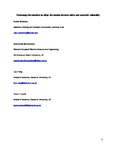Technology introduction on ships: the tension between safety and economic rationality
| dc.contributor.author | Bhardwaj, S | |
| dc.contributor.author | Bhattacharya, S | |
| dc.contributor.author | Tang, L | |
| dc.contributor.author | Howell, K | |
| dc.date.accessioned | 2019-02-21T17:48:49Z | |
| dc.date.issued | 2019-06 | |
| dc.identifier.issn | 0925-7535 | |
| dc.identifier.issn | 1879-1042 | |
| dc.identifier.uri | http://hdl.handle.net/10026.1/13335 | |
| dc.description.abstract |
This paper examines technology introduction on ships guided by three questions: (1) what drives technology introduction; (2) how seafarers are involved in the process; (3) what the consequences are in shipping. The data were collected through semi-structured interviews with ship managers and senior seafarer officers as well as a questionnaire study with seafarer officers. They reveal a discrepancy between the regulatory intention of technology introduction and the actual implementation process on ships. While the former is spurred by safety concerns, the latter is driven by economic rationality. This discrepancy makes technology a double edged sword in shipping. On the one hand, it plays an important role in improving safety, and on the other, it brings about work intensification and increased surveillance at workplace. | |
| dc.format.extent | 329-329 | |
| dc.language | en | |
| dc.language.iso | en | |
| dc.publisher | Elsevier | |
| dc.subject | Fatigue | |
| dc.subject | Paperwork | |
| dc.subject | Shipping | |
| dc.subject | Technology | |
| dc.subject | Work intensification | |
| dc.title | Technology introduction on ships: the tension between safety and economic rationality | |
| dc.type | journal-article | |
| dc.type | Article | |
| plymouth.author-url | https://www.webofscience.com/api/gateway?GWVersion=2&SrcApp=PARTNER_APP&SrcAuth=LinksAMR&KeyUT=WOS:000462690300031&DestLinkType=FullRecord&DestApp=ALL_WOS&UsrCustomerID=11bb513d99f797142bcfeffcc58ea008 | |
| plymouth.volume | 115 | |
| plymouth.publication-status | Published | |
| plymouth.journal | Safety Science | |
| dc.identifier.doi | 10.1016/j.ssci.2019.02.025 | |
| plymouth.organisational-group | /Plymouth | |
| plymouth.organisational-group | /Plymouth/Faculty of Arts, Humanities and Business | |
| plymouth.organisational-group | /Plymouth/Faculty of Arts, Humanities and Business/Plymouth Business School | |
| plymouth.organisational-group | /Plymouth/REF 2021 Researchers by UoA | |
| plymouth.organisational-group | /Plymouth/REF 2021 Researchers by UoA/UoA17 Business and Management Studies | |
| plymouth.organisational-group | /Plymouth/Research Groups | |
| plymouth.organisational-group | /Plymouth/Research Groups/Marine Institute | |
| plymouth.organisational-group | /Plymouth/Users by role | |
| plymouth.organisational-group | /Plymouth/Users by role/Academics | |
| dcterms.dateAccepted | 2019-02-21 | |
| dc.rights.embargodate | 2020-8-25 | |
| dc.identifier.eissn | 1879-1042 | |
| dc.rights.embargoperiod | Not known | |
| rioxxterms.versionofrecord | 10.1016/j.ssci.2019.02.025 | |
| rioxxterms.licenseref.uri | http://www.rioxx.net/licenses/all-rights-reserved | |
| rioxxterms.licenseref.startdate | 2019-06 | |
| rioxxterms.type | Journal Article/Review |


